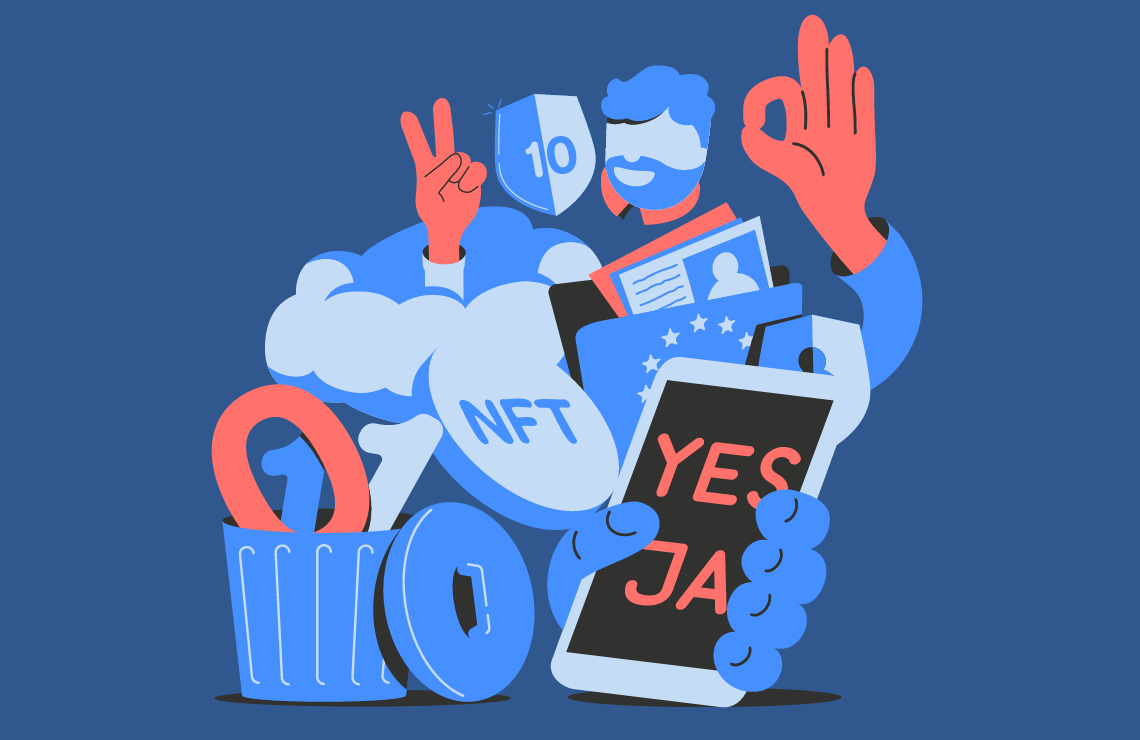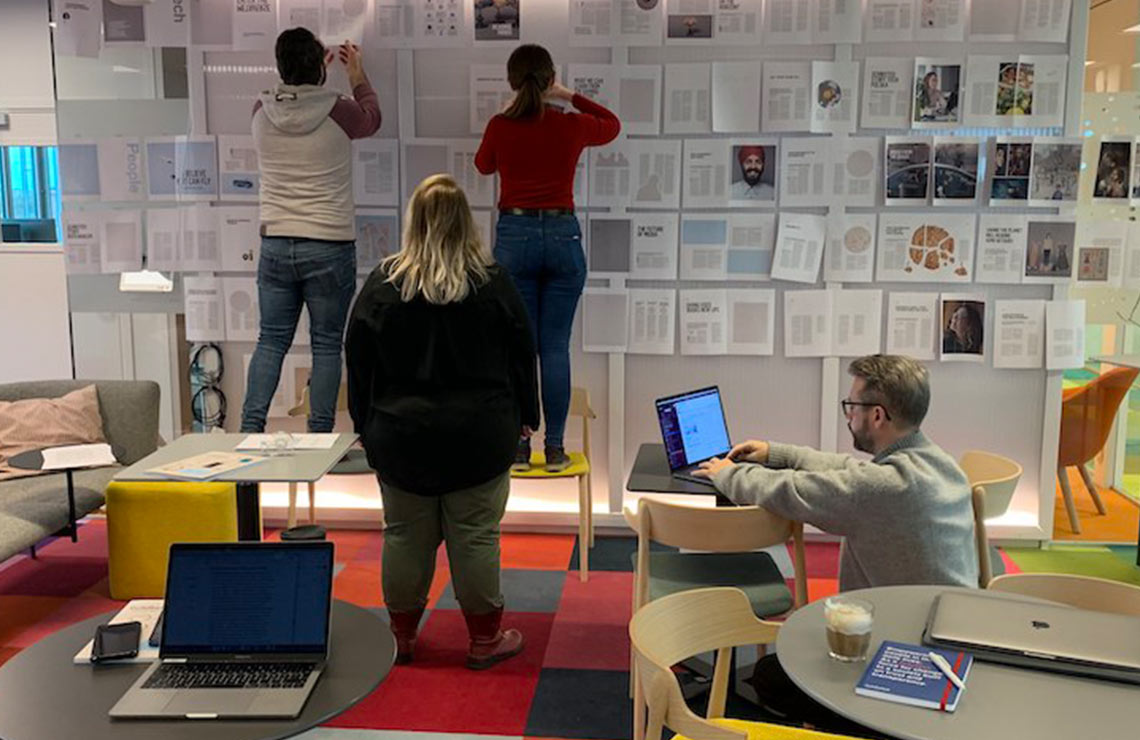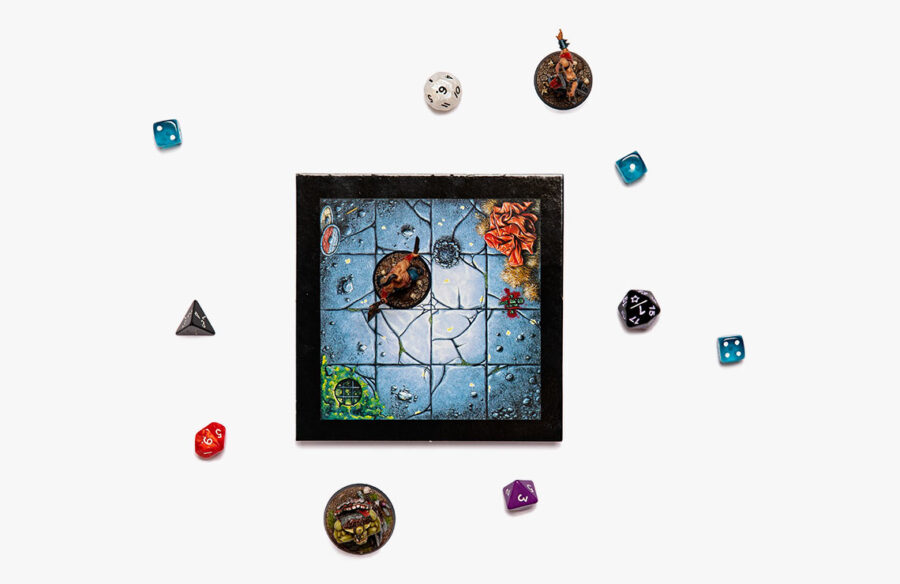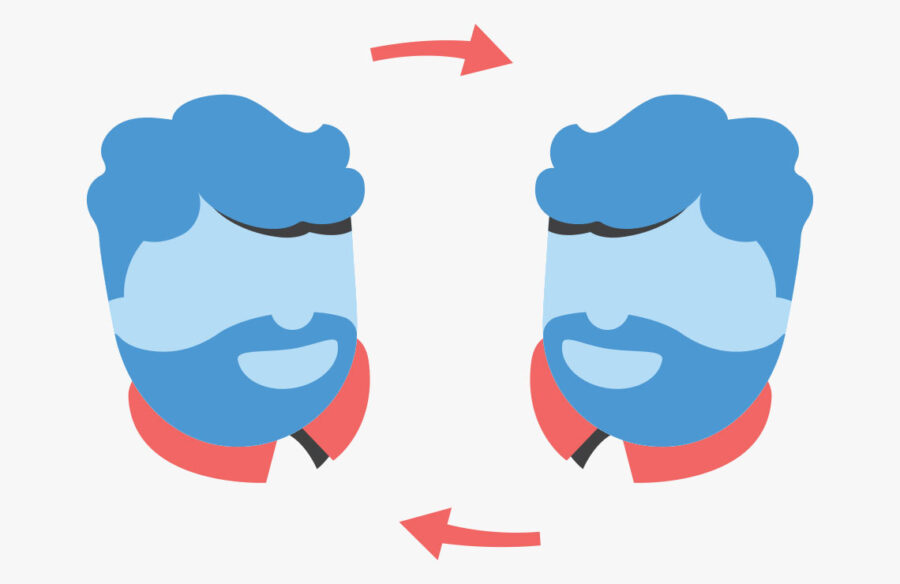3 Lessons We Can Learn from Orcs

3 Lessons We Can Learn from Orcs
When the futures we imagine confront our logic and business models – it might help to look at gaming
to break free from the gravity of the present.
The full moon hangs over the horizon, and a light rain begins to fall from heavy clouds. Your boots squelch in the mud as the pitter-patter of raindrops lulls you into a false sense of safety. A monstrous howl breaks the calm night, followed by several more, echoing from the forest around you. Whatever creatures lurk in the darkness have you and your companions surrounded. What do you do?
Over the last decade successful TV shows like Game of Thrones and Stranger Things, as well as live-streaming platforms like Twitch, have brought tabletop role playing games (TTRPGs) out of the basement and into the mainstream, as exemplified by the commercially successful Dungeons and Dragons which has developed a cult-like following.
Propelled by collaborative storytelling, TTRPGs share three characteristics. First, players take on the role of imagined characters, each with their own histories, motivations, strengths and weaknesses. Second, characters inhabit a fictional setting with its own internal logic, covering everything from medieval fantasy to space opera. Finally, these games use elements of chance and improvisation to resolve conflicts and create consequences of the characters’ actions.
Players often use their characters to explore parts of themselves or experience things to which they aren’t normally exposed. This can be an incredibly energising experience; imagine what it would feel like to actually save the world with your friends? Other times, this experience can be quite personal. In the game “14 Days”, players take on the role of someone living with severe migraines, and experience what the unpredictability of chronic pain means for them over the course of the two-week game. Simply using narrative and imagination can take us one step closer to empathy and experience.
What sets these games apart from their digital cousins is the near-complete freedom they offer. Not bound by the limitations of a script or computer program, the question “what do you do?” gives players the chance to take unconventional paths that they would otherwise miss. It builds a sense of agency and allows stories to unfold in emergent ways. Unconventional strategies can reward unique narrative turns.
In many games, this freedom is tempered by a Game Master (GM), who acts as referee of sorts, describing the context the characters are in, acting as any people they may meet in the world, and adjudicating the results when the outcome of the characters’ actions is uncertain. With multiple players making individual and collective decisions, the GM helps maintain the tone and direction of the narrative, providing believable consequences for the characters’ actions. Collaborative storytelling, meaningful cause and effect, and emergent plot twists are what makes these games unique.
While it has a very different goal, Strategic Foresight is a discipline that follows a very similar logic to TTRPGs. Used by leading companies and public institutions worldwide, including here at Schibsted by our Tech Experiments team, Strategic Foresight helps us imagine a range of possible futures and develop robust, forward-looking strategies in times of uncertainty. Like TTRPGs, it uses fictional, collaborative scenarios to explore different actions and imagine possible outcomes.
The process follows four core steps. First, we scan the present for signals of change, including market trends, news stories, and user behaviour. Second, we use these signals to identify trends affecting our organisation. Next, we extrapolate and create future scenarios, imagining our place in them. Finally, we identify and prioritise actions we can take today to move us towards our preferred future.
This can be a powerful approach to anticipating future trends, risks, and opportunities. It can also be an unsettling one. When the futures we imagine confront our logic and business models, how can we break ourselves free from the gravity of the present and imagine different paths going forward? This is where Strategic Foresight can draw lessons from TTRPGs.
Make it experimental
Part of what sets role-playing games apart from books, films or computer games is the feeling that you and your friends were actually there, living the story, even if it is fantastic and unbelievable. When working with Strategic Foresight, paradigm-shifting futures can be hard to believe; if we don’t have parallel experiences to draw on, how can we imagine what that future might feel like? This is where we can use design and storytelling to simulate those experiences. Building prototypes of future products and services that we can touch and experience can bridge the gap and make challenging futures more believable.
Make it divergent
Engaging stories are full of choice, conflict, failure and success. Role playing games embrace this and allow us to find opportunities we might have disregarded otherwise. In Strategic Foresight processes, it can be tempting to focus on the most preferable or probable future we identify. If we give ourselves the chance, these processes also provide low-investment, low-risk opportunities to explore novel paths and alternative strategies. This kind of divergent thinking helps challenge our approach to business-as-usual, adapt to unpredictable events and identify novel areas for exploration and investment.
Make it emergent
Collaborative storytelling means that no one at the table knows what will happen next. It builds excitement and a sense of ownership, and the collective choices of the players can lead to truly unpredictable twists. In parallel, one of the main challenges for Strategic Foresight is preparing organisations for unpredictable, so-called ‘Black Swan’ events, like global pandemics, as well as unforeseen areas of opportunity, like NFTs. To foster emergent thinking, Strategic Foresight processes should involve a diverse range of participants from across the organisation in a safe space for open discussion. Truly novel ideas can arise only when a mix of experiences, expertise and perspectives have a seat at the table and are given the chance to imagine together.

Christopher Pearsell-Ross
UX Designer
Years in Schibsted: 3 months
“I went from handicapped to cyborg”

“I went from handicapped to cyborg”
Last fall I became a cyborg. Now, when I tap twice on my left ear, I answer a phone call or hang up. If I tap twice on my right ear, I activate Siri. My new hearing aids make me feel superpowered. Improving our senses and bodies will be the future for all of us, says Sven Størmer Thaulow.
As a kid I handled the fact that I was born with a reduced hearing by compensating with lip-reading and being seated in the first row in the classroom. Later, in the army and at university – exposed to the myriads of Norwegian accents and most likely some effects of playing in bands – it became more tiresome to compensate, so I started using hearing aids.
Until last fall it has been a varied experience. They serve as an important support, but they lack in refinement – and always make me acutely aware of my handicap. But then something happened. For years we´ve talked about cyborgs and wearables, while techies implanted RFID chips under their skin to demo the future and numerous smart glasses with AR have been tested. But now I’m convinced that it’s within the audio space that things will take off. Superpowered hearing aids will become consumer electronics – filling the missing link in the audio interface ecosystem.

But the road to make me a cyborg has been long.
It all started with “in ear”-aids, devices that practically plugged my ears so that no natural sound could enter. In the mid-90s, I got the first programmable devices that could amplify sound on six different frequency bands. Then, in the early 2000s, came the tiny aids that hung behind my ear and that had a speaker connected by a fairly invisible chord. At that time, the buds stuck into my ear were full of holes, and amplification was much better, resulting in a more natural sound picture. These are still the default mode today. But all this time I still felt handicapped, and I didn’t like that they were visible – so I kept my hair long. Being a vocalist in a band was a good combination.
Around 2014, the first mobile connected hearing aid entered the scene. It was connected to the mobile through Bluetooth, not only in an app, but into the operating system IOS. The hearing aids worked like headphones and the voice audio was excellent – but they didn’t have a microphone. I had to hold up the phone to my mouth when speaking. You could also control different programs and the volume, either through an app or directly in the control centre on Iphone. I could also stream music from my Iphone – but the sound was optimised for voice, so it was treble-crap. But this started to become cool. So, I cut my hair.

Still, the potential was so much greater. When could I drop my airpods? Why weren’t the hearing aids truly connected two-ways so I could talk in them, talk to Siri, and get answers? I kept asking every year for innovations and I told my audiologist Heidi to call me when any great leaps were made on functionality.
Then came the breakthrough. Heidi called me in November 2020, asking me to come over. She handed me a hearing device called Phonak from the Swiss company Sonova Group. And now, after 15 years with hearing aids – I have officially become a cyborg. I don’t feel like I have a handicap anymore. I feel superpowered. Privileged. And I am sure this is the future for all humans.
I can use the aids as I do airpods when I talk on the phone. It’s almost a problem as people don’t have any visual cue that I am on a call. The audio quality is also close to the quality from airpods. I have now used these hearing aids for about twelve months, and I haven’t used my airpods at all. And I am listening to a lot of music.
But what’s probably the coolest thing about my new hearing aids is that they are gesture activated. If I tap twice on my left ear, I answer a phone call or hang up. If I tap twice on my right ear, I activate Siri and can ask whatever I want – hoping she will understand. I use it mostly for controlling Spotify, beefing up the volume, setting a timer, jotting down a to-do, sending a simple text message, etc. A few times I’ve asked questions like “who is xx”, but what you can do with this new audio interface is limited to the intelligence of Siri and not to the content or the value chain, which is super smooth.
For 17 of the 24 hours in a day, I am connected to the internet – inside my brain practically. It saves me loads of friction during the day; I probably pick up the phone 40–50 percent less. I don’t need to charge or look for my airpods either.

In my view, the true breakthrough of connected humans will come from medtech. And it starts here, with audio. And while I’m walking around with some fellow hearing-impaired cyborgs, waiting for my audiologist, Heidi, to reveal yet another breakthrough – here are some predictions about the soon-to-come future of the audio interface:
In five years from now you will be able to buy “Invisible Airpods” from Apple or equivalent. They will be the priciest Airpods you can get hold of, but way cheaper than my Phonaks (which are hovering around 1,400 USD in Norway).
“Invisible Airpods” will be the primary audio interface toward the internet. It’s always on you and it’s personal – so why bother with Google Home?
Siri will become a lot smarter and tailored towards “non-screen” communication. This means you won’t need to pick up your phone to browse through what Siri has found on the Internet when asking her a question. Just imagine you are about to have a meeting with someone and you’d like to get some information about them. Siri will be able to provide that, directly into your ear.
App providers will build in Siri support on loads of functions so that it’s possible to use functionality inside the apps without picking up the phone. Today there are very few apps that have implemented functions towards Siri, which is why “she” has limited reach on our phones.
I can’t wait for the next innovation in this space!

Sven Størmer Thaulow
EVP Chief Data and Technology Officer
Years in Schibsted: 2.5
An unprecedented moment in history

Kristin Skogen Lund, CEO Schibsted Media Group
An unprecedented moment in history
In 1839 Christian Schibsted started a small printing business. Two decades later, he founded the newspaper Aftenposten to branch out, which became Schibsted’s first example of rethinking its business.
Today, after 180 years of entrepreneurship, innovation and investments, Schibsted has grown into a family of strong brands ranging from media houses to online marketplaces, digital growth businesses, and start-up investors. We still carry with us both the values of our media heritage and that desire to branch out, go for growth, rethink and reinvent ourselves.
Our media heritage also inspires the Schibsted Future Report. This annual outlook on trends within tech, people and business is written by our own people and we truly believe that sharing ideas and being transparent is a foundation for democracy.
In the past year, our willingness to go for change and growth has given us the opportunity to consolidate the Nordic classifieds market, by acquiring the Danish classifieds marketplaces DBA and Bilbasen, and welcoming them into the Schibsted family. We believe this puts us in an even better position to deliver on our mission; to empower people in their daily lives.
we are witnessing two fundamental changes in the labour force
To keep growing, Schibsted (and everyone else) will have to deal with the fact that the world is at a crossroads. The digitalisation of society has taken leaps during the pandemic, and everyone is racing to build and maintain a digital relationship with their customers. To succeed, they will need developers, UX-experts, engineers and technologists. The problem is that there are too few to go around as it is.
According to Gartner’s Emerging Risks Survey 2021, global talent shortage is now the top emerging risk for all organisations. Korn Ferry estimates a worldwide deficit of 4.3 million tech-skilled workers by 2023, of which 1.5 million in Europe alone.
On top of that, studies carried out by Microsoft, among others, show that a high percentage of the workforce want the option of working remotely and are willing to change jobs to do so. What is more; remote job postings on Linkedin have increased five times since the pandemic outbreak.
In other words: we are witnessing two fundamental changes in the labour force simultaneously. First, a global shortage of tech people, which has already been named “the war for talent”. Second, a global talent migration in a border-free, post-pandemic labour market, often referred to as “the great reshuffle”.
However; one can compete on culture
There’s no easy way for employers to counter any of these fundamental changes. Competing on compensation and benefits alone, for instance, may prove to be difficult when the global giants have seemingly bottomless war chests in the war for talent. However; one can compete on culture – offering a better place to work, and one can compete on purpose – offering a more meaningful place to work.
I think we are facing an unprecedented moment in the history of work, where we all need to rethink not just how we work, but why we work. More people will be doing work they love at companies they feel passionate about. And this presents opportunities to organisations who engage their employees, offering trust and purpose.
I also think it is a good idea to showcase the talented people already working at the company, letting their ideas and voices be heard. And that is exactly what we do with the Schibsted Future report.

Kristin Skogen Lund CEO
Years in Schibsted: 3 as CEO and 6 as Commercial Director and CEO of Aftenposten 2004–2010
Crypto finance is going mainstream

Crypto finance is going mainstream
Cryptocurrencies have made decisive moves towards mainstream adoption in recent years. A May 2021 report by New York Digital Investment Group showed that 17 percent of American adults owned at least a fraction of Bitcoin. Among millennials, nearly half own some form of cryptocurrency.
Moving at a much slower pace behind buzzy cryptocurrencies such as Bitcoin and Dogecoin is the notion of decentralised finance (defi). Billed as finance for the internet age, it boils down to the notion that anyone in the world can lend, save, invest and borrow blockchain assets. Unlike today’s financial systems, defi is run on peer-to-peer networks where financial transactions take place through smart contracts – programs on the blockchain that only run when conditions between the buyer and the seller have been met. The users define the rules of engagement, not the institutions.
Anyone have access
The advantages of defi are numerous. Without institutions having the final word on financial transactions, anyone can access banking services. The same permissionless feature applies to the developers who build on these decentralised platforms. There’s also the added benefit of transparency, as software built on these decentralised networks is open-source, and transactions on the blockchain are recorded for all to see.
Furthermore, defi promises the benefit of 24/7 accessibility, unlike traditional financial institutions. Instead of subjecting their financial history to the whims of a bank manager, a defi user could use their Ethereum tokens (the crypto that powers many defi protocols) as collateral for the loan.
Global adoption of defi would have a disruptive effect on our current financial institutions
And rather than opening a savings account with a paltry interest rate, a user could stake certain coins, earning interest rewards far beyond those determined by central banks. By adding your tokens to the blockchain’s liquidity pool, you provide the capital to power other defi services. Many of today’s blockchains operate with these so-called Proof-of-Staking models, an environmentally friendlier alternative to Bitcoin’s Proof-of-Work framework. The user (and their crypto) help serve as the infrastructure.
Disruptive effect
Global adoption of defi would have a disruptive effect on our current financial institutions, reengineering everything we understand about costly financial services such as transfers and global remittances. Banks are particularly exposed to risk – even digital-savvy banks still largely operate by a traditional set of rules. Not surprisingly, some banks have begun commissioning analysis studies and stating that it’s “time to cooperate” with defi.
Defi still has a steep barrier to entry though. It requires a high level of internet savvy to understand. Another downside is the inherent volatility of many cryptocurrencies. The Ethereum tokens you stake on a pool, for example, could drop 20 percent in value over the course of a week (although the opposite is also true).
As I write this, Defi Pulse reports that there are 83 billion USD of assets locked up in defi protocols. Q1 2021 saw 1.5 trillion USD worth of transactions settled with Ethereum, an amount that the venture capital firm Andreesen Horowitz noted represents 50 percent of Visa’s payment volume. Given the sheer volume of capital involved, it’s a question of when, not if, defi will start to play a central role in how we handle our money.

Jeremy Cothran
Former Editor, Schibsted Daily
Years in Schibsted: 1.5
Tech trends in short

Tech trends in short
Non-fungible tokens, deepfakes and decentralised finance. The future of tech gives us many new opportunities and concepts, but also a sensible need for regulation and structure.
Cyber scores
Just like people and companies have credit scores today, we will likely see the development of cyber scores in the near future. Companies and organisations will be ranked on how they’ve stood up to cyber threats and how secure their data is. In the long run, a good cyber score could be as important as a good credit score.
Deepfakes
Deepfakes are becoming more believable every day and are already being used in both novel and malicious ways. The tech behind deepfakes will become more sophisticated, and wider use of it has the potential to erode trust on social media even further. Here, we believe regulation will be necessary in the not too distant future.
Regulation for tech
We’re already seeing a need for regulation around AI and transparency in tech with proposals like the EU’s Artificial Intelligence Act. Trust is key when it comes to implementing new technologies, and regulation will need to be part of building that trust going forward.
No-code and tech democratisation
The democratisation of tech will continue. The effort to make tech-led innovation as accessible as possible has been ongoing, but the continued investment in AI and the evolution of software-as-a-service companies will strengthen that effort. The increasing need for people skilled in tech has led to an explosion of self-service and “do-it-yourself” solutions. No-code interfaces will
also keep evolving, limiting the need to know code to develop tech services and products.
Artificial Intelligence
Calling AI a trend is an understatement; AI is being adopted as a technology in a vast part of society. One specific field of special interest for Schibsted is within natural language processing. In light of this, Schibsted is currently building a new Norwegian language model, together with other media companies, the Norwegian national library, NTNU and professor Jon Atle Gulla.
Non-fungible token
Non-fungible tokens and virtual assets will keep evolving, especially as Big Tech keeps investing in virtual spaces. As the adoption of NFTs in the art and entertainment spaces increases, more companies will get involved in creating them for profit. We will see an increasing need for expertise around the tokenisation process and requirements in this space.
Cloud solutions
Hand in hand with the democratisation of tech is the continued evolution of cloud solutions. Companies have experienced first-hand during the pandemic how important it is to have cloud infrastructure to be able to not only store and access data remotely, but to work within the cloud as well.
Credits 2021

The Future Report team in Stockholm in action.
Future Report 2022 Credits
Produced by Schibsted Group Communication, Nov 2021.
Editor
Art Director
Photo Editor
Emma-Sofia Olsson
Page Design
David Stillberg
Text and editing
Images
Emma-Sofia Olsson, Andreas Lewandowski, Johan Lagerwall, David Stillberg, Thomas Molén, Martin Slottemo Lyngstad, Haakon Nordvik, Lars Pehrson, Malin Hoelstad, Carolina Byrmo, Martin Stenmark, Kyrre Lien, Andreas Bardell, Rune Sævig, Magnus Wennman, Stig B Hansen, Fereshteh Eslahi, Magnus Hjalmarson Neideman, Monica Strømdahl, Emil Wesolowski, Adobe Stock, Phonak.
Contributors
Kristin Skogen Lund, Andreas Cervenka, Camilla Buch, Sam Sundberg, Sven Størmer Thaulow, Jeremy Cothran, Christopher Pearsell-Ross, David Gill, John Einar Sandvand, Joacim Lund, Erica Treijs, Ann Axelsson, Britt Nilsen, Petter Larsson, Mette Krogsrud, Einar Hålien, Siv Juvik Tveitnes, Zuzanna Zygadlo-Stenberg, Anders Grimstad, Christian Horn Hanssen, Dan Ouchterlony, Linda Christine Strande, Hanne Hollstedt.
Social
Schibsted on Twitter
Schibsted on Instagram
schibsted.com
Göteborgstryckeriet
PAPER Arctic Matt and Munken Krystall















